Strategic Management Report: Virgin Australia Business Strategies
VerifiedAdded on 2022/11/14
|5
|1172
|335
Report
AI Summary
This report provides an analysis of Virgin Australia's strategic management, focusing on its business and corporate strategies within the Australian airline sector. It examines Michael Porter's generic strategies, highlighting Virgin Australia's alignment with cost leadership and differentiation to increase revenue and improve its market position. The report discusses the airline's repositioning strategy, its implementation of marketing strategies, and its collaboration with other airlines for global expansion. It also explores the use of perceptual mapping to understand the evolution of Virgin Australia's services and products. The conclusion emphasizes the importance of competitive advantage through strategic choices to ensure sustained growth in the airline industry. References include academic research and industry reports to support the analysis.
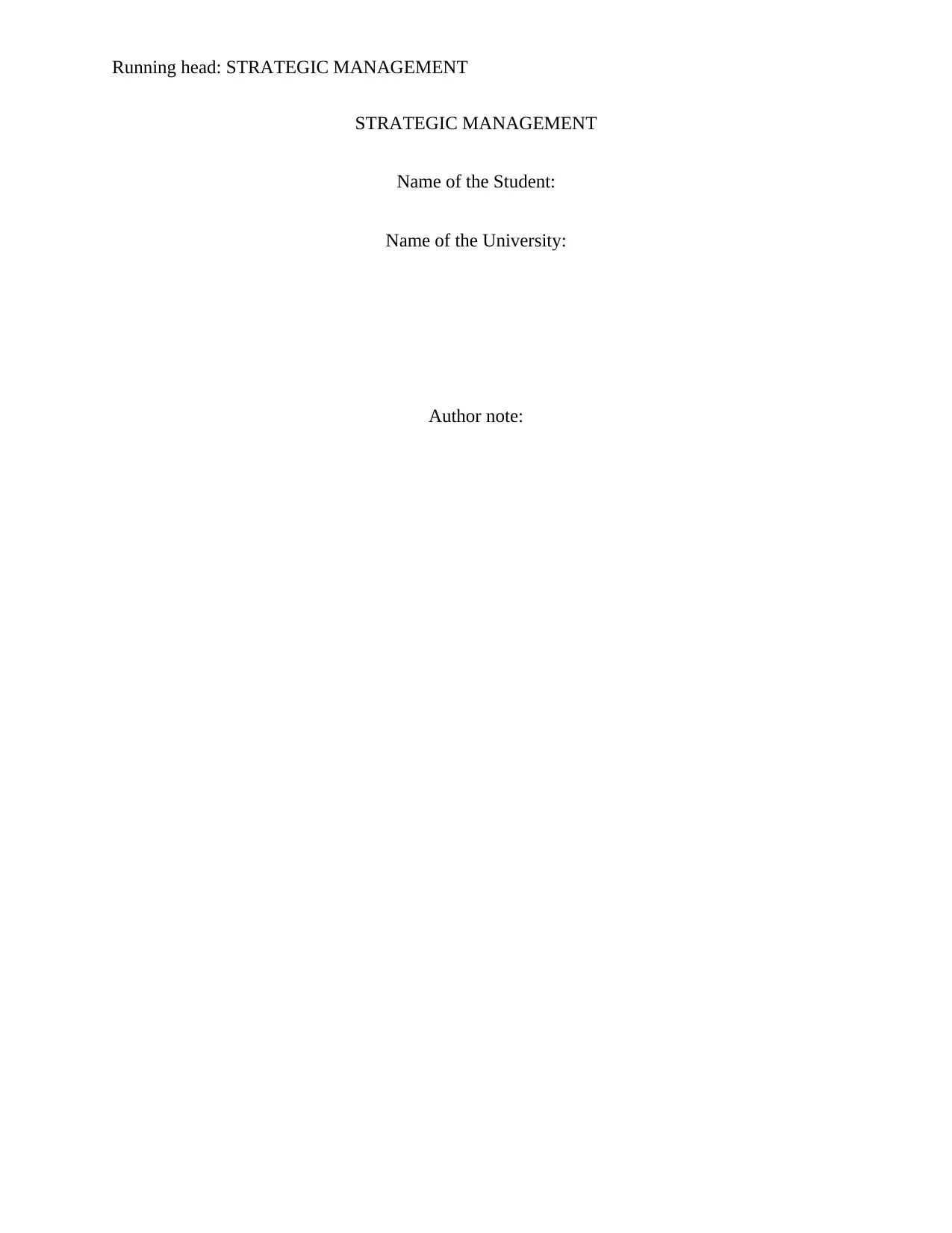
Running head: STRATEGIC MANAGEMENT
STRATEGIC MANAGEMENT
Name of the Student:
Name of the University:
Author note:
STRATEGIC MANAGEMENT
Name of the Student:
Name of the University:
Author note:
Paraphrase This Document
Need a fresh take? Get an instant paraphrase of this document with our AI Paraphraser
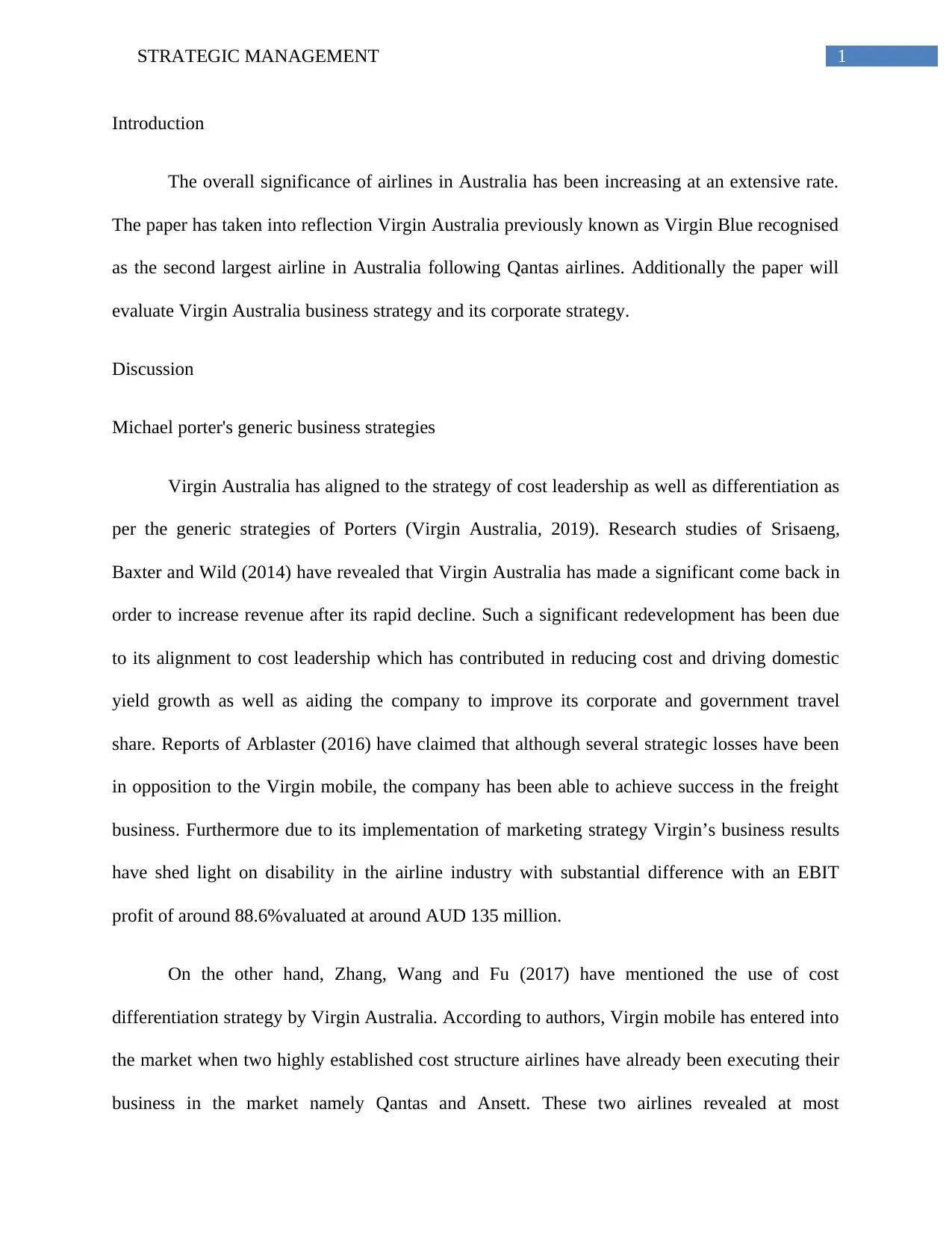
1STRATEGIC MANAGEMENT
Introduction
The overall significance of airlines in Australia has been increasing at an extensive rate.
The paper has taken into reflection Virgin Australia previously known as Virgin Blue recognised
as the second largest airline in Australia following Qantas airlines. Additionally the paper will
evaluate Virgin Australia business strategy and its corporate strategy.
Discussion
Michael porter's generic business strategies
Virgin Australia has aligned to the strategy of cost leadership as well as differentiation as
per the generic strategies of Porters (Virgin Australia, 2019). Research studies of Srisaeng,
Baxter and Wild (2014) have revealed that Virgin Australia has made a significant come back in
order to increase revenue after its rapid decline. Such a significant redevelopment has been due
to its alignment to cost leadership which has contributed in reducing cost and driving domestic
yield growth as well as aiding the company to improve its corporate and government travel
share. Reports of Arblaster (2016) have claimed that although several strategic losses have been
in opposition to the Virgin mobile, the company has been able to achieve success in the freight
business. Furthermore due to its implementation of marketing strategy Virgin’s business results
have shed light on disability in the airline industry with substantial difference with an EBIT
profit of around 88.6%valuated at around AUD 135 million.
On the other hand, Zhang, Wang and Fu (2017) have mentioned the use of cost
differentiation strategy by Virgin Australia. According to authors, Virgin mobile has entered into
the market when two highly established cost structure airlines have already been executing their
business in the market namely Qantas and Ansett. These two airlines revealed at most
Introduction
The overall significance of airlines in Australia has been increasing at an extensive rate.
The paper has taken into reflection Virgin Australia previously known as Virgin Blue recognised
as the second largest airline in Australia following Qantas airlines. Additionally the paper will
evaluate Virgin Australia business strategy and its corporate strategy.
Discussion
Michael porter's generic business strategies
Virgin Australia has aligned to the strategy of cost leadership as well as differentiation as
per the generic strategies of Porters (Virgin Australia, 2019). Research studies of Srisaeng,
Baxter and Wild (2014) have revealed that Virgin Australia has made a significant come back in
order to increase revenue after its rapid decline. Such a significant redevelopment has been due
to its alignment to cost leadership which has contributed in reducing cost and driving domestic
yield growth as well as aiding the company to improve its corporate and government travel
share. Reports of Arblaster (2016) have claimed that although several strategic losses have been
in opposition to the Virgin mobile, the company has been able to achieve success in the freight
business. Furthermore due to its implementation of marketing strategy Virgin’s business results
have shed light on disability in the airline industry with substantial difference with an EBIT
profit of around 88.6%valuated at around AUD 135 million.
On the other hand, Zhang, Wang and Fu (2017) have mentioned the use of cost
differentiation strategy by Virgin Australia. According to authors, Virgin mobile has entered into
the market when two highly established cost structure airlines have already been executing their
business in the market namely Qantas and Ansett. These two airlines revealed at most
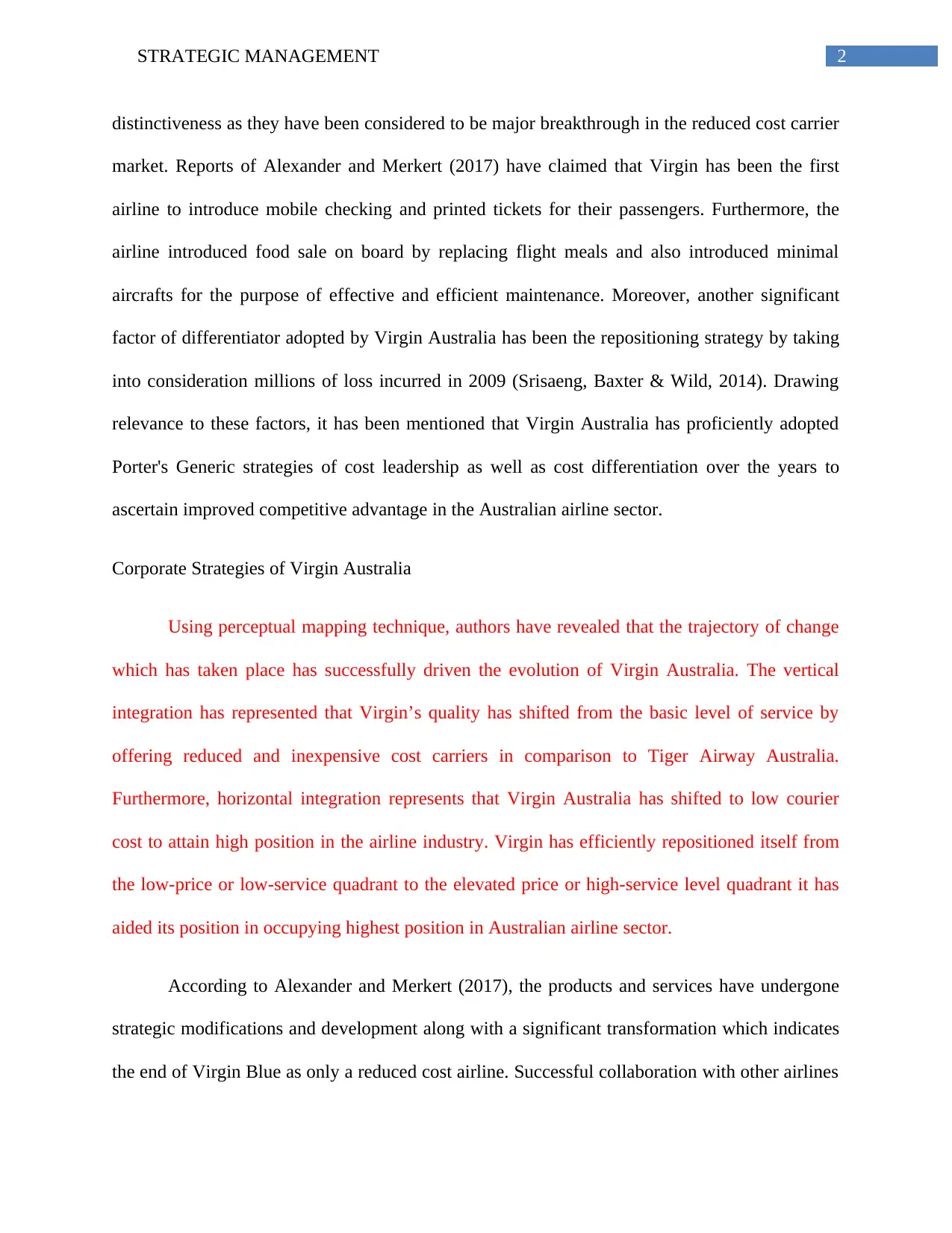
2STRATEGIC MANAGEMENT
distinctiveness as they have been considered to be major breakthrough in the reduced cost carrier
market. Reports of Alexander and Merkert (2017) have claimed that Virgin has been the first
airline to introduce mobile checking and printed tickets for their passengers. Furthermore, the
airline introduced food sale on board by replacing flight meals and also introduced minimal
aircrafts for the purpose of effective and efficient maintenance. Moreover, another significant
factor of differentiator adopted by Virgin Australia has been the repositioning strategy by taking
into consideration millions of loss incurred in 2009 (Srisaeng, Baxter & Wild, 2014). Drawing
relevance to these factors, it has been mentioned that Virgin Australia has proficiently adopted
Porter's Generic strategies of cost leadership as well as cost differentiation over the years to
ascertain improved competitive advantage in the Australian airline sector.
Corporate Strategies of Virgin Australia
Using perceptual mapping technique, authors have revealed that the trajectory of change
which has taken place has successfully driven the evolution of Virgin Australia. The vertical
integration has represented that Virgin’s quality has shifted from the basic level of service by
offering reduced and inexpensive cost carriers in comparison to Tiger Airway Australia.
Furthermore, horizontal integration represents that Virgin Australia has shifted to low courier
cost to attain high position in the airline industry. Virgin has efficiently repositioned itself from
the low-price or low-service quadrant to the elevated price or high-service level quadrant it has
aided its position in occupying highest position in Australian airline sector.
According to Alexander and Merkert (2017), the products and services have undergone
strategic modifications and development along with a significant transformation which indicates
the end of Virgin Blue as only a reduced cost airline. Successful collaboration with other airlines
distinctiveness as they have been considered to be major breakthrough in the reduced cost carrier
market. Reports of Alexander and Merkert (2017) have claimed that Virgin has been the first
airline to introduce mobile checking and printed tickets for their passengers. Furthermore, the
airline introduced food sale on board by replacing flight meals and also introduced minimal
aircrafts for the purpose of effective and efficient maintenance. Moreover, another significant
factor of differentiator adopted by Virgin Australia has been the repositioning strategy by taking
into consideration millions of loss incurred in 2009 (Srisaeng, Baxter & Wild, 2014). Drawing
relevance to these factors, it has been mentioned that Virgin Australia has proficiently adopted
Porter's Generic strategies of cost leadership as well as cost differentiation over the years to
ascertain improved competitive advantage in the Australian airline sector.
Corporate Strategies of Virgin Australia
Using perceptual mapping technique, authors have revealed that the trajectory of change
which has taken place has successfully driven the evolution of Virgin Australia. The vertical
integration has represented that Virgin’s quality has shifted from the basic level of service by
offering reduced and inexpensive cost carriers in comparison to Tiger Airway Australia.
Furthermore, horizontal integration represents that Virgin Australia has shifted to low courier
cost to attain high position in the airline industry. Virgin has efficiently repositioned itself from
the low-price or low-service quadrant to the elevated price or high-service level quadrant it has
aided its position in occupying highest position in Australian airline sector.
According to Alexander and Merkert (2017), the products and services have undergone
strategic modifications and development along with a significant transformation which indicates
the end of Virgin Blue as only a reduced cost airline. Successful collaboration with other airlines
⊘ This is a preview!⊘
Do you want full access?
Subscribe today to unlock all pages.

Trusted by 1+ million students worldwide
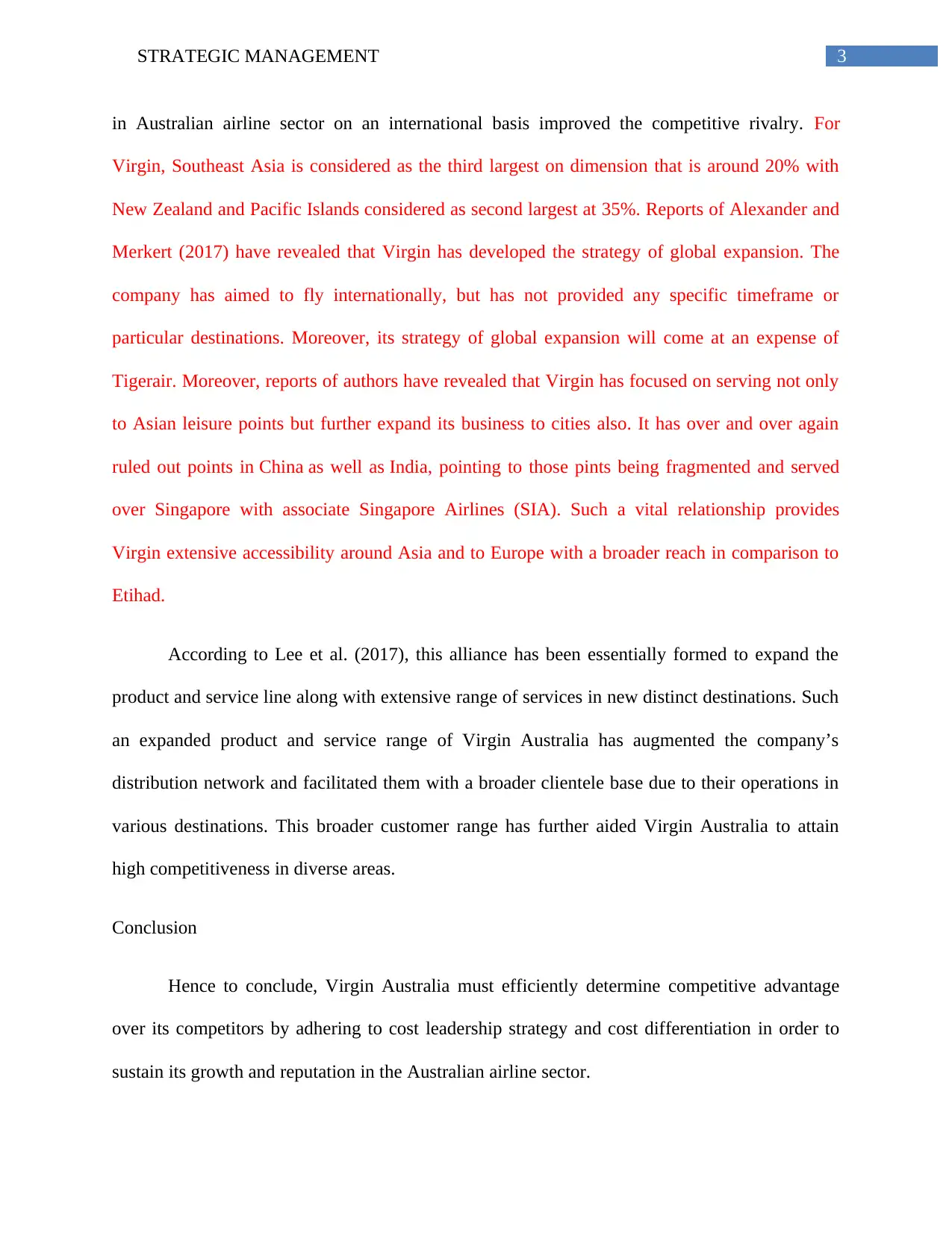
3STRATEGIC MANAGEMENT
in Australian airline sector on an international basis improved the competitive rivalry. For
Virgin, Southeast Asia is considered as the third largest on dimension that is around 20% with
New Zealand and Pacific Islands considered as second largest at 35%. Reports of Alexander and
Merkert (2017) have revealed that Virgin has developed the strategy of global expansion. The
company has aimed to fly internationally, but has not provided any specific timeframe or
particular destinations. Moreover, its strategy of global expansion will come at an expense of
Tigerair. Moreover, reports of authors have revealed that Virgin has focused on serving not only
to Asian leisure points but further expand its business to cities also. It has over and over again
ruled out points in China as well as India, pointing to those pints being fragmented and served
over Singapore with associate Singapore Airlines (SIA). Such a vital relationship provides
Virgin extensive accessibility around Asia and to Europe with a broader reach in comparison to
Etihad.
According to Lee et al. (2017), this alliance has been essentially formed to expand the
product and service line along with extensive range of services in new distinct destinations. Such
an expanded product and service range of Virgin Australia has augmented the company’s
distribution network and facilitated them with a broader clientele base due to their operations in
various destinations. This broader customer range has further aided Virgin Australia to attain
high competitiveness in diverse areas.
Conclusion
Hence to conclude, Virgin Australia must efficiently determine competitive advantage
over its competitors by adhering to cost leadership strategy and cost differentiation in order to
sustain its growth and reputation in the Australian airline sector.
in Australian airline sector on an international basis improved the competitive rivalry. For
Virgin, Southeast Asia is considered as the third largest on dimension that is around 20% with
New Zealand and Pacific Islands considered as second largest at 35%. Reports of Alexander and
Merkert (2017) have revealed that Virgin has developed the strategy of global expansion. The
company has aimed to fly internationally, but has not provided any specific timeframe or
particular destinations. Moreover, its strategy of global expansion will come at an expense of
Tigerair. Moreover, reports of authors have revealed that Virgin has focused on serving not only
to Asian leisure points but further expand its business to cities also. It has over and over again
ruled out points in China as well as India, pointing to those pints being fragmented and served
over Singapore with associate Singapore Airlines (SIA). Such a vital relationship provides
Virgin extensive accessibility around Asia and to Europe with a broader reach in comparison to
Etihad.
According to Lee et al. (2017), this alliance has been essentially formed to expand the
product and service line along with extensive range of services in new distinct destinations. Such
an expanded product and service range of Virgin Australia has augmented the company’s
distribution network and facilitated them with a broader clientele base due to their operations in
various destinations. This broader customer range has further aided Virgin Australia to attain
high competitiveness in diverse areas.
Conclusion
Hence to conclude, Virgin Australia must efficiently determine competitive advantage
over its competitors by adhering to cost leadership strategy and cost differentiation in order to
sustain its growth and reputation in the Australian airline sector.
Paraphrase This Document
Need a fresh take? Get an instant paraphrase of this document with our AI Paraphraser
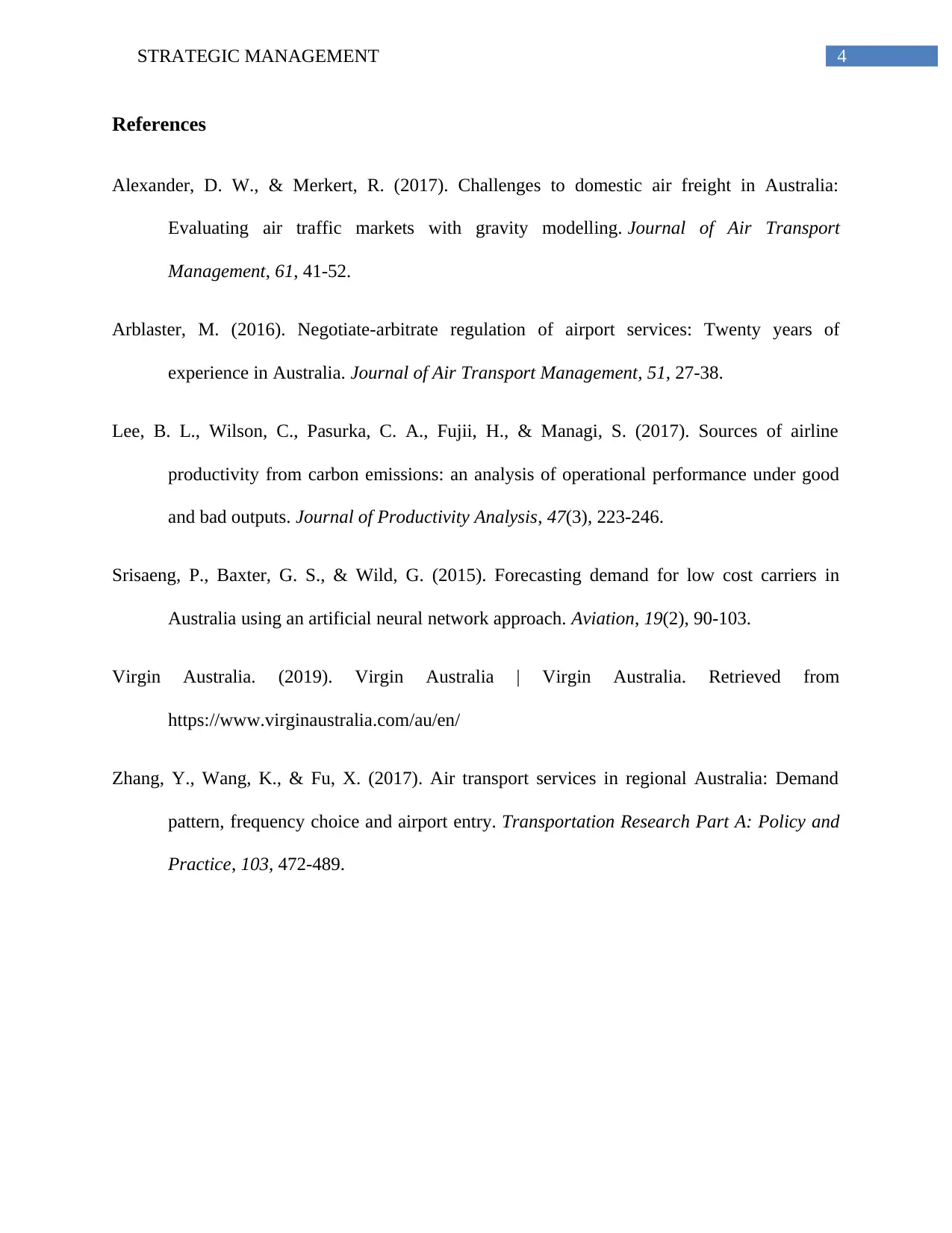
4STRATEGIC MANAGEMENT
References
Alexander, D. W., & Merkert, R. (2017). Challenges to domestic air freight in Australia:
Evaluating air traffic markets with gravity modelling. Journal of Air Transport
Management, 61, 41-52.
Arblaster, M. (2016). Negotiate-arbitrate regulation of airport services: Twenty years of
experience in Australia. Journal of Air Transport Management, 51, 27-38.
Lee, B. L., Wilson, C., Pasurka, C. A., Fujii, H., & Managi, S. (2017). Sources of airline
productivity from carbon emissions: an analysis of operational performance under good
and bad outputs. Journal of Productivity Analysis, 47(3), 223-246.
Srisaeng, P., Baxter, G. S., & Wild, G. (2015). Forecasting demand for low cost carriers in
Australia using an artificial neural network approach. Aviation, 19(2), 90-103.
Virgin Australia. (2019). Virgin Australia | Virgin Australia. Retrieved from
https://www.virginaustralia.com/au/en/
Zhang, Y., Wang, K., & Fu, X. (2017). Air transport services in regional Australia: Demand
pattern, frequency choice and airport entry. Transportation Research Part A: Policy and
Practice, 103, 472-489.
References
Alexander, D. W., & Merkert, R. (2017). Challenges to domestic air freight in Australia:
Evaluating air traffic markets with gravity modelling. Journal of Air Transport
Management, 61, 41-52.
Arblaster, M. (2016). Negotiate-arbitrate regulation of airport services: Twenty years of
experience in Australia. Journal of Air Transport Management, 51, 27-38.
Lee, B. L., Wilson, C., Pasurka, C. A., Fujii, H., & Managi, S. (2017). Sources of airline
productivity from carbon emissions: an analysis of operational performance under good
and bad outputs. Journal of Productivity Analysis, 47(3), 223-246.
Srisaeng, P., Baxter, G. S., & Wild, G. (2015). Forecasting demand for low cost carriers in
Australia using an artificial neural network approach. Aviation, 19(2), 90-103.
Virgin Australia. (2019). Virgin Australia | Virgin Australia. Retrieved from
https://www.virginaustralia.com/au/en/
Zhang, Y., Wang, K., & Fu, X. (2017). Air transport services in regional Australia: Demand
pattern, frequency choice and airport entry. Transportation Research Part A: Policy and
Practice, 103, 472-489.
1 out of 5
Related Documents
Your All-in-One AI-Powered Toolkit for Academic Success.
+13062052269
info@desklib.com
Available 24*7 on WhatsApp / Email
![[object Object]](/_next/static/media/star-bottom.7253800d.svg)
Unlock your academic potential
Copyright © 2020–2025 A2Z Services. All Rights Reserved. Developed and managed by ZUCOL.





